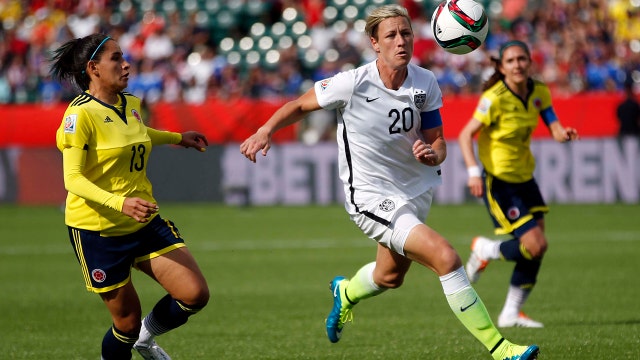Soccer star Abby Wambach fights for concussion safety
When U.S soccer champion Abby Wambach suffered a concussion in 2013 she realized just how quickly her career could be taken away from her. Today, she’s raising awareness on concussion safety and a new wearable device that can help
Did you know who Ed Cunningham is? Probably not. Cunningham, a college football analyst for ESPN, was unknown to all but hardcore football fans. But by tying himself closely to a politically correct cause – in this case, resigning his position Wednesday, in a protest over concussions in football – he is guaranteed fawning media coverage. The New York Times is leading the Cunningham canonization.
With the new college football season for most teams starting this weekend, the resignation seems timed for maximum attention. But the politically correct movement seems much more focused on opposing what is uniquely American than where players actually face the greatest risks of concussion.
In college, women's soccer has a higher rate of concussions than men's football or soccer. Indeed, among college sports, women's soccer has the highest rate of concussions.
In college, women's soccer has a higher rate of concussions than men's football or soccer: 6.3 per 10,000 times women participate in soccer practice or a game versus 4.9 for men's soccer and 6.1 for men's football. Men's wrestling and hockey have even higher rates at 12.4 and 8.4 respectively.
But concussions aren't the only problem. In total injuries, both men's and women's soccer exceed those of men's football. Total injuries for men's soccer are 11.14 per 10,000 practices or games and 9.7 for women's soccer. For football, the number is 9.5.
College sports are about twice as likely as high school sports to result in concussions. At the high school level, the numbers for soccer aren't quite as bad as for football. High school football is the riskiest. But girls' and boys' soccer are still the second and third most dangerous sports for concussions, followed closely by girls' basketball.
There is also data showing that, while football causes a higher number of concussions, girls and boys' high school soccer is responsible for more of the serious concussions. We can tell that from the recovery time. Concussions from soccer are about twice as likely as football to require 22 or more days of recovery.
Most concussions in soccer occur for the same reason that they happen in football - collisions with other players. But in soccer, there is another problem: striking one's head against a hard ball over and over again. In high school, contact with "equipment" (mostly the ball) is about nine times more likely to cause concussions in boys' soccer than in football. Soccer balls are even more dangerous for women.
Unfortunately, soccer players are much less likely than football players to recognize that they have suffered a concussion. So, they are less likely to take the time to rest and get treatment.
An article in the Journal of Neurology compared professional soccer players from several professional Dutch clubs with a control group of elite noncontact-sport athletes. The study found professional soccer players exhibited relatively severely impaired performances in memory, planning, and visual perceptions. How poorly they functioned was related directly to how frequently the players had "headed" the soccer ball.
Politicians haven’t been able to stay out of the discussion. The number two Democrat in the Senate, minority whip Dick Durbin, D-Ill., has introduced legislation mandating research on concussions in football, hockey, basketball, and baseball, but there is no mention of soccer.
Senators Tom Udall, D-N.M., Amy Klobuchar, D-Minn., and Richard Blumenthal, D-Conn., want to mandate stricter safety standards for high school football helmets. Former President Obama has strongly warned Americans about the risks of playing football, going so far this year as saying, "I would not let my son play pro football."
If football is such a scourge, where is the concern over soccer or other sports? Indeed there are a number of sports that are less "safe" than football.
Soccer might currently be the "in" and politically-correct sport, but parents who push their children into playing it for safety reasons are in for a rude surprise.

